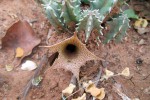| Home | > | List of families | > | Apocynaceae subfamilies Asclepiadoideae and Secamonoideae | > | Huernia |
6887.000 Huernia
Bruyns, P.V. (2005) Stapeliads of Southern Africa and Madagascar Volume I Umdaus Press, Hatfield, South Africa
Bruyns, P.V., Klak, C. & Hanáček, P. (2017) A revised, phylogenetically-based concept of Ceropegia (Apocynaceae) South African Journal of Botany 112 399-436
Leistner, O.A. (ed.) (2000) Seed plants of southern Africa: families and genera Strelitzia 10
Description of the genus
Stems fleshy, glabrous, 4-5(-6)-angled, tubercled with rudimentary leaves arising from the centre of the tubercle, without stipules. Inflorescence a pedunculate cyme, often arising from the base of the stem. Sepals ovate-lanceolate, acuminate. Corolla shape variable, with or without an annulus; 5-lobed, with 5 minor lobes in the sinuses; inside usually papillose or tuberculate, rarely smooth; margin without cilia. Corona of two rows, each of 5 lobes; inner and outer well separated vertically; outer lobes united to form a disk; inner lobes arising at the top of the staminal column, smooth, simple; usually with a transverse ridge or gibbosity at their base. Follicles erect, glabrous. Seeds with an apical tuft of hairs. Comment: More recent phylogenetic evidence has led to the forming of a very broad concept of the genus Ceropegia including the genus Brachystelma and all known genera within the Stapeliae (Bruyns, P.V., Klak, C. & Hanáček, P., 2017). However we follow Goyder et Al. in Flora Zambesiaca 7(2), 2020 where the inclusion of the Stapeliad genera has not been accepted. Worldwide: 64 species in tropical and South Africa; also Saoudi Arabia Botswana: 5 taxa. Insects associated with this genus:
|
 |
Links to taxa: View: living plant images - herbarium specimen images - all images for this genus
| Species | FZ divisions | Content |
| levyi Oberm.[VU] | Description, Image | |
| longituba N.E. Br. | SW,SE | Description, Image |
| thuretii F. Cels | ? | |
| verekeri Stent var. verekeri | N,SE | Description, Image |
| zebrina N.E. Br. subsp. zebrina | Description, Image |
Other sources of information about Huernia:
Our websites:
Flora of Caprivi: HuerniaFlora of Malawi: Huernia
Flora of Mozambique: Huernia
Flora of Zambia: Huernia
Flora of Zimbabwe: Huernia
External websites:
African Plants: A Photo Guide (Senckenberg): HuerniaBHL (Biodiversity Heritage Library): Huernia
EOL (Encyclopedia of Life): Huernia
GBIF (Global Biodiversity Information Facility): Huernia
Google: Web - Images - Scholar
iNaturalist: Huernia
IPNI (International Plant Names Index): Huernia
JSTOR Plant Science: Huernia
Mansfeld World Database of Agricultural and Horticultural Crops: Huernia
Plants of the World Online: Huernia
Tropicos: Huernia
Wikipedia: Huernia
| Home | > | List of families | > | Apocynaceae subfamilies Asclepiadoideae and Secamonoideae | > | Huernia |